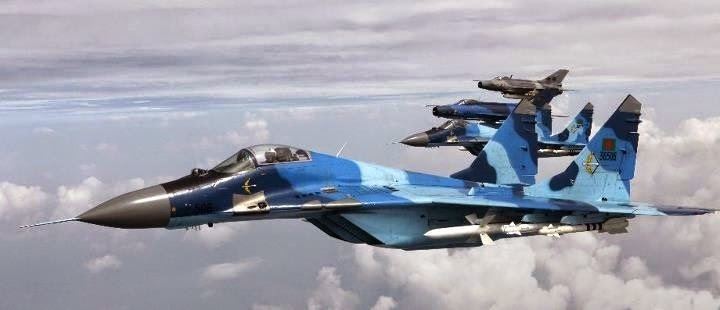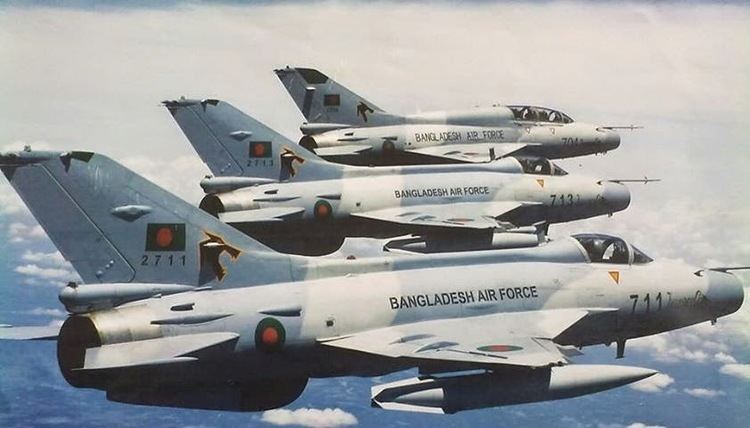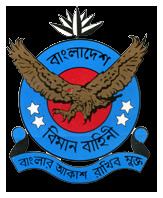Active 1971–present Type Military aviation Color Light Sky, Deep sky | Country Bangladesh Role Aerial warfare Founded 1971 | |
 | ||
Allegiance People's Republic of Bangladesh Size 17,000 personnel148 aircraft Motto বাংলার আকাশ রাখিব মুক্ত; Transliteration:Banglar Aakash Rakhibo Mukto; (Free shall we keep the sky of Bangladesh) Fighters Mikoyan MiG-29, Chengdu J-7 Similar Bangladesh Army, Bangladesh Navy, Bangladesh Armed Forces, Border Guards Bangladesh, Belgian Air Component | ||
The Bangladesh Air Force (Bengali: বাংলাদেশ বিমান বাহিনী, Bangladesh Biman Bahini, reporting name: BAF), is the aerial warfare branch of the Bangladesh Armed Forces, primarily tasked with the air defence of Bangladesh territory and providing air support to the Bangladesh Army and Navy. Additionally, the service has a territorial role of providing strategic air transport and logistics capability for the country. The Bangladesh Air Force employs around 17,000 full-time personnel, including 3,500 pilots and currently operates close to 150 aircraft.
Contents
- Foundation
- Air Force personnel in 1971
- Non combatant staff
- Distinguished personnel
- After independence
- Forces Goal 2030
- List of the Chiefs of Air Staff
- Operations
- Organisation
- Branches officer
- Trades Airmen
- Installations
- Future modernisation programme
- References

Since its establishment on 21 September 1971, the Air Force has been involved in various combat and humanitarian operations, from the Bangladesh Liberation War in which it was born to supporting international efforts including the Coalition of the Gulf War and United Nations peacekeeping missions.

Foundation
The Bangladesh Air Force was officially formed at the Sector Commanders Conference during its independence war from Pakistan in 1971. Its official date of formation has been established as 28 September 1971 and it was launched formally by the Government on 8 October 1971. Out of 11 BDF Sectors, the most tactically significant sector, the Central Sector - Sector 11, was in command of a BAF officer including Sector 6. A significant number of BAF personnel participated in the Bangladesh War of Independence. Initially, BAF was formed with all officers and airmen of Bengali origin serving in the Pakistan Air Force prior to the war. At that time, the embryo of Bangladesh Air Force BAF) was formed with less than a hundred officers and a quite good number of airmen and warrant officers. During the independence war, officers of the BAF attached to the Z-Force were then Bangladesh Gov't Representative to Chakulia Guerilla Trng. Camp Squadron Leader M. Hamidullah Khan, later Sub-Sector Commander and as Commander-Sector 11, Flight Lieutenant Liaqat as Battalion Adjutant, Flying Officer Rouf, Flying Officer Ashraf and Flight Sergeant Shafiqullah as company commanders. Squadron Leader Sadruddin Hossain, Squadron Leader Wahidur Rahim, Squadron Leader Nurul Qader, Squadron Leader Shamsur Rahman and Air Commodore Ataur Rahman as sub sector company commanders. Squadron Leader Khademul Bashar participated in the war as Commander-Sector 6.
Bangladesh Air Force was organised in India with the initiative of Squadron Leader Sultan Mahmud (Ex-PAF Pilot), Captain Shahabuddin Ahmed (Ex-PIA Pilot), Captain Akram Ahmed (Ex-Plant protection Pilot) and Captain Sattar (ex-PIA Pilot) and Captain Sarfuddin (Ex-PIA Pilot). Later many Bangladeshi ex-PAF Officers joined in Bangladesh Air Force in India. Finally, Bangladesh Air Force was formed in late July 1971. Indian Air Force trained these Officers July 1971 through November 1971 as fighter pilots. Bangladesh Air Force first went in action on 3 December 1971 and attacked the Chittagong-based Oil tank depot and oil tank depot was totally destroyed by that air attack. The Air attack was conducted by Capt. Akram Ahmed. The second Bangladesh Air Force attack was on 6 December 1971 at Moulovi Bazar Pakitani Army barracks under the command of Squadron Leader Sultan Mahmud, where Captain Shahabuddin Ahmed was co-pilot.

Indian civilian authorities and the IAF donated 1 DC-3 Dakota (gifted by the Maharaja of Jodhpor), 1 Twin Otter plane, and 1 Alouette III helicopter for the newborn Bangladesh Air Force, which was to take advantage of the lack of night-fighting capability of the PAF to launch hit-and-run attacks on sensitive targets inside Bangladesh from the air. The Bengali rank and file fixed up the World War II vintage runway at Dimapur, then began rigging the aircraft for combat duty. The Dakota was modified to carry 500 pound bombs, but for technical reasons it was only used to ferry Bangladesh government personnel. Captain Abdul Khalek, Captain Alamgir Satter, and Captain Abdul Mukit, all destined to earn the Bir Pratik award, piloted the Dakota. The helicopter was rigged to fire 14 rockets from pylons attached to its side and had .303 Browning machine guns installed, in addition to having 1-inch (25 mm) steel plate welded to its floor for extra protection. Squadron Leader Sultan Mahmood, Flight Lieutenant Bodiul Alam, and Captain Shahabuddin, all of whom later won the Bir Uttam award, operated the helicopter. The Otter boasted 7 rockets under each of its wings and could deliver ten 25 pound bombs, which were rolled out of the aircraft by hand through a makeshift door. Flight Lt. Shamsul Alam, along with Captains Akram Ahmed and Sharfuddin Ahmad, flew the Otter - all three were later awarded Bir Uttam for their service in 1971. This tiny force was dubbed Kilo Flight, the first fighting formation of the nascent Bangladesh Air force. Squadron Leader Sultan Mahmud was appointed as the commander of the 'Kilo Flight'.
Air Force personnel in 1971
During the Bangladesh War of Independence 1971, many career Air Force officers from eastern Pakistan and airmen participated in different sectors in Bangladesh and also at the headquarters. Below are a list of some notable participants:
Non-combatant staff
Group Captain A K Khandker PAF-BAF – Was assigned as the Deputy Chief of Staff at the end of July 1971 under Lieutenant Colonel Abdur Rab who remained in Comilla during the war. His primary responsibility consisted of liaison with local Indian officials and defence personnel at Kalyani, Calcutta.
Distinguished personnel
After independence
After independence, the BAF received a significant donation from the former USSR. Among the aircraft delivered were ten single-seat Mikoyan-Gurevich MiG-21MFs and two twin-seat Mikoyan-Gurevich MiG-21UMs. Later China also supplied some equipment.
Apart from the aircraft of Kilo Flight which were donated to India, most Pakistan Air Force aircraft grounded in Dhaka due to runway cratering by the Indian Air Force during the liberation war, were sabotaged before surrender. Many of these were also returned to service by Bangladeshi ground technicians. The Pakistan Air Force prior to 1971 had many Bengali pilots, air traffic controllers, technicians and administrative officers. Many of them distinguished themselves during the Bangladesh Liberation War, they provided the nascent Bangladesh Air Force with a good number of trained personnel.
Defence co-operation improved with Pakistan considerably under the military regimes of Ziaur Rahman and Hossain Mohammad Ershad in Bangladesh, which had grown more distant from its war ally, India. Common concerns over India's regional power have influenced strategic co-operation leading to a gift of several squadrons of refurbished Shenyang F-6 fighter aircraft from Pakistan to the Bangladesh Air Force in the late 1980s. Bangladesh Air Force Academy (BAFA) received National colours in 2003 by the then honourable Prime Minister. Even the Recruits’ Training School (RTS) has been awarded with BAF Colours by ex-Chief of Air Staff (AVM Fakhrul Azam) in 2004.
Forces Goal 2030
The Bangladesh Air Force has an ambitious modernisation plan to be implemented in upcoming years under Forces Goal 2030. As per the goal, air force is to be a strong deterrent force to well protect the sky of Bangladesh. Plans are made to strengthen both air power and land based air defence capabilities. BAF has taken the delivery of sixteen Chengdu F-7BGI fighter aircraft, nine K-8W basic trainer aircraft, eleven Mil Mi-171Sh combat transport helicopters, three Let L-410 Turbolet transport trainer aircraft, sixteen Yakovlev Yak-130 advanced jet trainers and two AgustaWestland AW139 maritime SAR helicopters from 2010 to 2015. BAF is now awaiting to take delivery of 11 PT-6 basic trainers and two training helicopters.
BAF earned the Surface to Air Missile capability by introducing FM-90 short range air defence missile in 2011. Bangladesh air force will receive Italian origin long range Selex RAT-31DL air defence radar and a short range air defence radar soon.
Plans are there to procure eight multirole combat aircraft, six Mi-171Sh helicopters, two maritime search and rescue helicopters, one medium range surface-to-air missile system and one unmanned aerial vehicle system soon.
List of the Chiefs of Air Staff
Main Article : Chief of Air Staff of the Bangladesh Air Force
Operations
More than 600+ BAF personnel, including officers and airmen, 10 BAF helicopters and are currently deployed to various UN Missions. Another C-130 transport aircraft is providing support to UN Mission in Africa. With the deployment of C-130 aircraft and its personnel, Bangladesh became the largest troops contributing country in UN Peace Keeping Missions.
Organisation
According to the Constitution of Bangladesh, President of Bangladesh act as the civilian Commander-in-chief, and Chief of Air Staff (COAS), by statute a four-star air officer (Air Chief Marshal), commands the Air Force. The Bangladesh Air Force is currently commanded by Air Chief Marshal Abu Esrar,BBP,ndc,acsc.
The Bangladesh Air Force (BAF) has its HQ at Dhaka Cantonment. HQ has 3 branches, Operations & Training (Ops. & Trng.), Administration and Special Duties (Admin. & SD) and Material & Maintenance (M & Mte). Each branch is headed by officers who are considered as Principal Staff Officer (PSO) and known as Assistant Chief of Air Staff, e.g. ACAS (Ops & Trng). Under each PSO there are various Directorates headed by Directors of Group Captain/Air Commodore Rank. Under each Director there are Deputy Directors (DD) headed by Wing Commanders and Staff Officers(SO)with rank of Squadron Leader and below.
Branches (officer)
Branches of Bangladesh Air Force are:
Trades (Airmen)
Trades of Bangladesh Air Force are:
Installations
BAF Headquarters is located in Dhaka Cantonment. There are numerous bases set up all over the country. BAF Base Khademul Bashar Dhaka, BAF Base Bangabandhu Dhaka, BAF Base Zahurul Haque Chittagong and BAF Base Matiur Rahman Jessore are named after National as well as Air Force heroes. Other major bases are BAF Base Pahar Kanchanpur Tangail and Forward Operations Base at Cox's Bazar. There are also several independent units and detachments in places like Moulavibazar Radar Unit (MRU), Bogra Radar Unit (BRU), Lalmonirhat Unit, No. 74 Squadron Bangladesh Air Force at Chittagong and No.71 Squadron Bangladesh Air Force at Dhaka and Shamshernagar.
Bangladesh Air Force Academy is the commissioned officer training academy for all branches of Bangladesh Air Force. It is located at BAF Base Matiur Rahman in Jessore. Recruits Training School is the airman training centre for all trades of Bangladesh Air Force. It is located at BAF C&M Unit Shamshernagar in Moulvibazar.
Future modernisation programme
The BAF has an ongoing modernisation programme under Forces Goal 2030 to become a strong force to defend the sky of Bangladesh. It has plans to acquire modern aircraft and land based air defence capabilities.
Bangladesh is negotiating with the US government for the regeneration, overhaul, modifications and logistics support for four off-the-shelf Lockheed Martin C-130Es, 20 engines and associated parts, equipment, and training for an estimated cost of $180 million.
Bangladesh Air Force ordered a Selex RAT-31DL L Band AESA radar from Leonardo-Finmeccanica of Italy worth approximately US$19 million. This radar will be set up in Barisal to bolster the security of the southern Bangladesh.
Minister of Law Anisul Huq informed the Bangladesh Parliament about current and future procurement plans for the Bangladesh Air Force on 8 December 2016. He said that the contracts has been signed for the procurement of 11 PT-6 basic trainers, two training helicopters, one long-range air surveillance radar system and one short-range air surveillance radar system in the fiscal year 2015-16. He also added that the plans have been taken to procure eight multirole combat aircraft, six Mi-171Sh helicopters, two maritime search and rescue helicopters, one medium range surface-to-air missile system and one unmanned aerial vehicle system in the fiscal year 2016-17. He added that more multirole combat aircraft (MRCA), medium lift helicopter and Mobile pulse Doppler Radar (MPDR) will be procured in the future.
In February 2017, BAF has floated a tender for the procurement of one battery of medium range surface to air missile (MRSAM) system consisting of one command vehicle, one search/target designation radar vehicle, one guidance radar vehicle and four missile firing vehicle. Each firing vehicle will have minimum four missiles.
